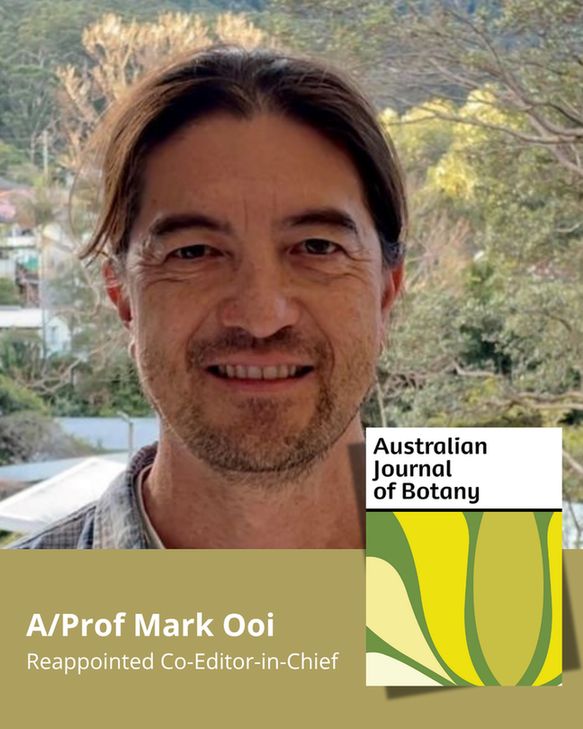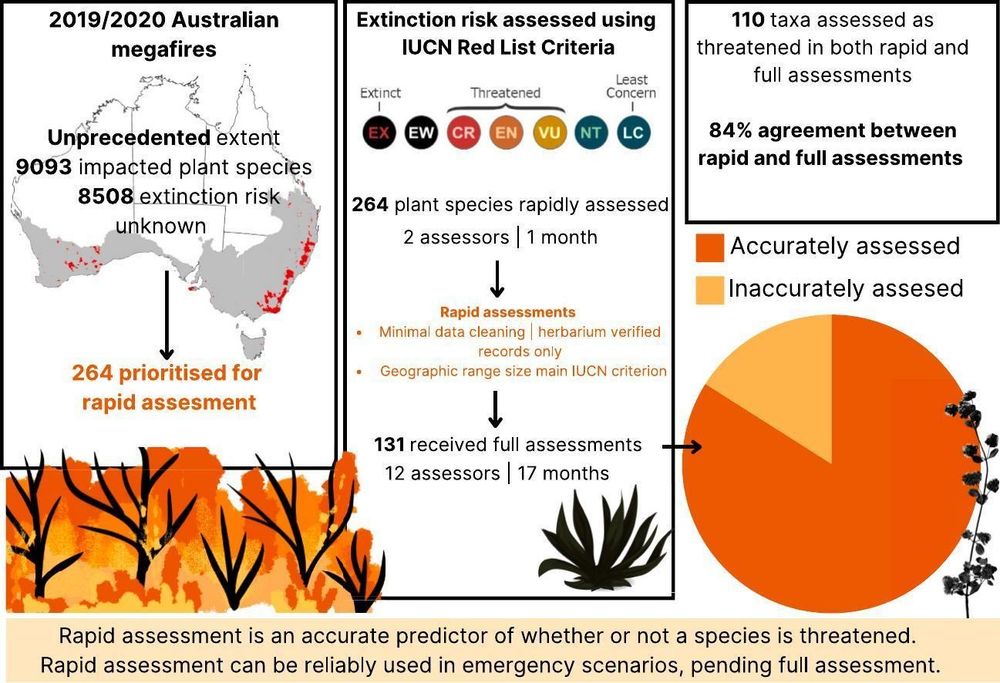Thanks for the shout-out Tim! In my other life, I always wanted to be a photographer 😊
03.11.2025 05:21 — 👍 4 🔁 0 💬 1 📌 0
The first chapter of my PhD is out! 🌱🔥
We looked at whether fatty acids (a common seed oil) changed composition across fire-prone and fire-free habitats + dormancy-breaking temperatures in physically dormant seeds! (1/2)
@markooiecol.bsky.social @ryantangney.bsky.social
doi.org/10.1093/aob/...
20.10.2025 01:05 — 👍 11 🔁 3 💬 1 📌 0
I was wondering the same!
01.10.2025 15:52 — 👍 1 🔁 0 💬 1 📌 0

The "living fossil" Wollemi pine🌲can self-fertilise! New research from #CharlesSturtUni shows this critically endangered conifer produces viable seeds without cross-pollination - which helps explain their low genetic diversity in natural systems 🧬
Open access paper 🔗 buff.ly/l3yG5Rt
27.08.2025 04:19 — 👍 20 🔁 11 💬 0 📌 0

A dense, intricate cluster of golden-brown roots and rootlets from the grasstree Kingia australis, displayed against a white background. The cluster shows a complex branching structure with a main parent root extending horizontally, from which hundreds of fine secondary roots and rootlets emerge in all directions, creating a dense, bushy appearance. Photo credit: Byron Lamont.
The text on the image reads: "An eroding riverbank exposed the hidden root systems of the grasstree, Kingia australis."
Riverbank erosion in SW Australia exposed previously undocumented root clusters in Kingia australis. Research by Lamont et al. suggests these novel 'kingioid roots' enhance water and nutrient uptake rather than storage, linking with seasonal root-cluster types🫚
Paper here 🔗 buff.ly/Hi3BxLE
03.09.2025 04:42 — 👍 20 🔁 6 💬 0 📌 1

🌱 New research from The Australian PlantBank reveals how 4 threatened Australian Grevillea species respond to temperature changes. Good news, 3 species show resilience to future warming, but G. iaspicula prefers cooler conditions & may struggle with climate change.
Read more 🔗 buff.ly/b4pbbgv
10.09.2025 06:01 — 👍 9 🔁 4 💬 0 📌 0
CSIRO PUBLISHING | Journals
Read and Publish
Are you eligible for APC-free #OpenAccess? 🌱
Researchers from institutions with agreements in place between their library and CSIRO Publishing can publish #OA in our journal without needing to pay Article Processing Charges (APCs).
Find your institution:
www.publish.csiro.au/journals/ope...
14.07.2025 01:27 — 👍 3 🔁 2 💬 0 📌 0
Traits such as spines & water storage vessels allow #cacti to thrive in #aridecosystems. These traits are also useful indicators of #ecosystemintegrity. Paredes Cubas & colleagues from @universidadjaen explore 12 standardised measures of functional traits in #Cactaceae 🌵🔗https://buff.ly/Rc1J5K4
03.08.2025 03:00 — 👍 4 🔁 1 💬 0 📌 0

🌿 How did plants respond to postglacial warming near Tasmania’s treeline?
New research by Astorga et al. shows that some species survived the Last Glacial period locally, while others, like fire-adapted shrubs, arrived much later.
Read more in Australian Journal of Botany 🔗 doi.org/10.1071/BT24...
25.06.2025 23:26 — 👍 9 🔁 6 💬 0 📌 0

In New Caledonia’s rainforests, the rare monocarpic tree Cerberiopsis candelabra may owe its success to fast seasonal growth and high juvenile survival. Salmon et al. tracked 134 individuals for 18 months, revealing traits that may help them thrive after disturbance 🌱
🔗Read more: buff.ly/CUN2V5V
02.07.2025 03:00 — 👍 5 🔁 4 💬 0 📌 0

Finite resources, lots of species requiring conservation. @saltandbrine.bsky.social asks the question - how far do we go for each plant species? A simple question generating deep thought! #ICCB2025
17.06.2025 04:10 — 👍 9 🔁 1 💬 0 📌 0


We're delighted to announce the reappointment of @jwmorganecology.bsky.social and @markooiecol.bsky.social as Co-Editors-in-Chief of Australian Journal of Botany!
Their continued leadership ensures the journal remains at the forefront of botanical research in Australia and beyond 🌱 📖
13.06.2025 02:27 — 👍 29 🔁 8 💬 0 📌 0

Ox-eye daisy (Leucanthemum vulgare Lam.) invasion has only a small effect on the diversity of a subalpine grassland
Context Ox-eye daisy (OED; Leucanthemum vulgare) has invaded subalpine communities in Australia.Aims We evaluated the effect of OED on subalpine grassland diversity in Kosciuszko National Park…
Addition and removal experiments by McDougall et al. in subalpine grassland within Kosciuszko National Park reveal that the invasive Ox-eye daisy affects grassland diversity. Luckily, undisturbed communities seem resilient to the daisy's invasion despite its abundance.
🔗 ⬇️
11.05.2025 04:59 — 👍 5 🔁 3 💬 0 📌 0

New paper out! After the 2019-2020 #fires in Australia our team undertook #IUCN Red List assessments of fire affected #plant species, to handle the volume we undertook paired rapid and full assessments and compared their accuracy 1/4
doi.org/10.1016/j.bi...
12.05.2025 07:43 — 👍 28 🔁 14 💬 1 📌 0

Seagrass restoration in NSW

Sunset at Fowlers Gap. Photo by R. Freeman

Desert dawn in Sturt National Park

Rocky shore in the Sydney region
BEES is now on Bluesky. Looking forward to sharing the latest news and research from staff and students.
27.03.2025 06:57 — 👍 13 🔁 3 💬 0 📌 0

The covers of five journals, Australian Journal of Primary Health, Australian Journal of Botany, Reproduction, Fertility and Development, Wildlife Research, and Australian Journal of Chemistry.
Five of our journals are now on Bluesky!
Aus J Botany: @ausjbotany.bsky.social 🌱
Aus J Chem: @ausjchem.bsky.social 🧪
Aus J Primary Health: @ausjph.bsky.social 🩺
Reproduction, Fertility & Development: @repfertdev.bsky.social 🥚
Wildlife Research: @wildliferesearchj.bsky.social 🐾
13.03.2025 00:10 — 👍 14 🔁 7 💬 1 📌 1

Australian Journal of Zoology: evolutionary, molecular and comparative zoology.
We're seeking Associate Editors to join the #AusJZoology editorial board!
Associate Editors help manage the peer review process, uphold the journal's high publication ethics, and contribute to the publication of impactful zoological research.
Find out more: www.publish.csiro.au/zo/Expressio...
10.03.2025 23:31 — 👍 5 🔁 4 💬 0 📌 0

Fire ecology database for documenting plant responses to fire events in Australia - Scientific Data
Scientific Data - Fire ecology database for documenting plant responses to fire events in Australia
Fire ecology database for documenting plant responses to fire events in Australia
by José Rafael Ferrer-Paris, Ada Sánchez-Mercado, David Keith @willcornwell.bsky.social @markooiecol.bsky.social et al.
www.nature.com/articles/s41...
09.03.2025 21:47 — 👍 33 🔁 15 💬 0 📌 0

Honeybee visitation and native plant pollination Australia
Honeybee visitation and native plant pollination Australia What insect pollinators are visiting flowers in your area? Are the pollinators European honeybees or are they something else? As varroa mite ...
To get started we are launching a citizen science project on iNaturalist where anyone can contribute images of honeybees or native pollinators visiting native flowers so we can have a baseline for how flower visitation changes before and after varroa mite reaches different parts of the country 4/5
11.03.2025 01:39 — 👍 11 🔁 7 💬 1 📌 0
There is a huge need for more research on pollination in native species and support for existing work. Collection of baseline data is crucial as is monitoring already threatened species. There may also be unexpected impacts arise through interactions with other threats like fragmentation or fire 3/5
11.03.2025 01:39 — 👍 4 🔁 2 💬 1 📌 0

A figure showing the impending spread of varroa mite across Australia and the possibly positive effects of a reduced honeybees on fruit set for some native plant species
We found a decline in feral honeybees will be good news for some plants and bad news for others. But we found major gaps in our knowledge of how honeybees influence native plant pollination and pollinators. The loss of feral honeybees due to varroa mite is an opportunity to fill these gaps 2/5
11.03.2025 01:39 — 👍 3 🔁 1 💬 2 📌 0
Varroa mite arriving in Australia has been a big worry for agriculture and bee keeping but it will also result in a massive decline in feral honeybee populations. This will affect many native plant species visited by honeybees, our new paper aimed to understand what those effects might be 1/5
11.03.2025 01:39 — 👍 14 🔁 7 💬 1 📌 1
Research Scholarships | Western Sydney University
Western Sydney University PhD scholarship round is now open
[Australian & New Zealand citizens|residents only]
If you are interested in doing a PhD on arbuscular mycorrhizal fungi, fungal ecology & related topics then get in touch with me.
www.westernsydney.edu.au/schools/grs/...
25.02.2025 02:29 — 👍 20 🔁 15 💬 0 📌 1
Interested in plant development, cell polarity, Ca+2 and ROS homeostasis, plant cell wall integrity, signalling, protein translation. @Fundacionleloir CONICET Argentina & @CBVUNAB iBIO Chile. Currently Editor at @NewPhytologist, @CommsBiology @PlantComms
Plant Environmental Memory Lab at IABIMO, INTA-CONICET |
ex #JSPSFellow 🇯🇵 |
🇦🇷 ARG PlantWomen |
Editor Annals of Botany, AoB PLANTS |
#SeedBiology #WomenInScience
Plant researcher at Indiana University
~ plant pathogen interactions ~
also janky cats, tropical fruit trees, tiny goats
Apprentice Petalsmith
CNRS researcher in plant biology, Montpellier, France
Ecologist working on island ecology 🏝️, tropical ecology, ecological networks, species interactions, seed dispersal 🐦🐢🫐, restoration ecology, biological invasions 👽, community ecology, global change 🌍
📍Postdoctoral researcher at @IMEDEA_UIB_CSIC
Plant Scientist. Senior Research Leader, Royal Botanic Gardens, Kew.
SER advances the science, practice, and policy of ecological restoration.
Biologist & Dad. Research Fellow at ANU studying plant responses in a hotter, less predictable world. On Ngunnawal Country. Global Change Biology & Ecophysiology.
Official account of @ecolsocaus.bsky.social Plant-Soil Ecology Special Interest Network.
https://www.ecolsoc.org.au/category/research-chapters/plant-soil-ecology/
PhD Candidate at UNSW Sydney
Marine Bioacoustician
🧬🌿 | Birds | Fish | My Cat
A PhD student with the Botanic Gardens of Sydney and USyd. Working on genetics behind Myrtle rust and paperbarks for restoration.
Tldr: #wetlands #plantdisease #genetics #botany #restoration #ecology
PhD student working on improving conservation genomics for threatened plants 🌿 Focused on methods, frameworks & cross-species insights 🌱 University of Sydney + Botanic Gardens of Sydney (ReCER)
Editor in Australia now with CSIRO Publishing.
Book ideas welcome: Animals, marine and freshwater, natural environment, food and agriculture, soils, plants & fungi, science and society.
Linktree: Books, contact, and links: https://linktr.ee/editoring
Flagship journal of the Society for Conservation Biology. Applied science for scientists, managers, practitioners, decision makers. Editor: Mark Burgman. https://bit.ly/4iozgVS
Established by Western Sydney University in 2011, our fundamental and applied research is providing innovative solutions for protecting the environment, preserving biodiversity, ensuring food security, and sustainable use of natural resources.
Researching tropical grassy ecosystems and fire ecology at UNESP 🇧🇷 | Coordenated by @alefidelis.bsky.social | Posts by @gabrieladezotti.bsky.social or @heloizazirondi.bsky.social | #FireEcology #VegetationEcology #SavannaEcology
TT-IV Fellow at @leveg.bsky.social 🇧🇷 | Forb enthusiast 🪻| Tropical savannas & open ecossystems 🌾| Advocating for FAIR open science 🔓 | #SavannaEcology #DataScience | https://gabrieladezotti.github.io/gdezotti.github.io/
The Earth BioGenome Project (EBP), a moonshot for biology, aims to sequence, catalog, and characterize the genomes of all of Earth's eukaryotic biodiversity over a period of ten years.
🌲Keep up with all EBP updates: https://linktr.ee/earthbiogenomeproject
Ecologist and PhD candidate at UNSW Centre for Ecosystem Science with a particular interest in birds.






















